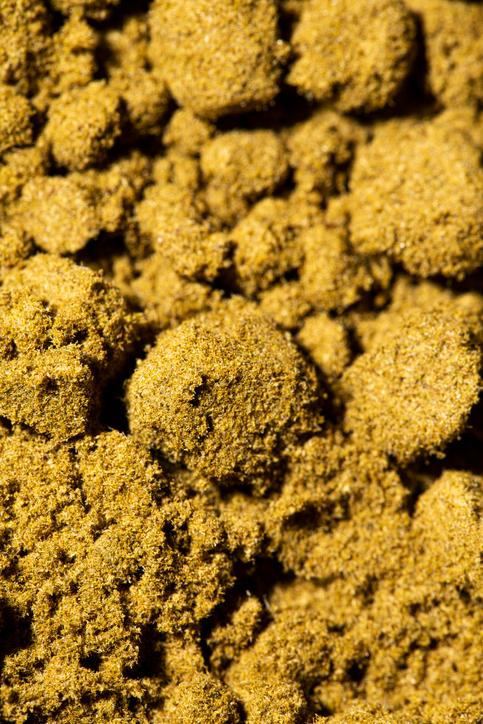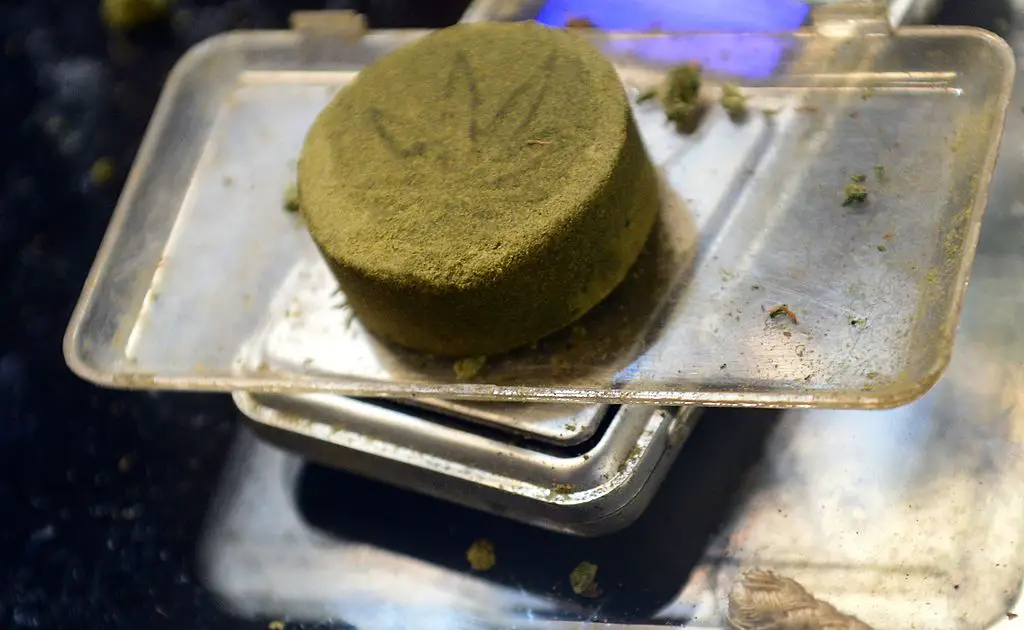Selecting the right micron-sized bag for kief extraction is a nuanced decision influenced by various factors. The primary consideration is the type of input material, be it flower, hash, kief, or others, followed closely by the balance between quality and yield.
The dilemma is clear: opt for superior extract quality with a smaller yield or prioritize a larger yield at the expense of quality. Striking the right balance is the challenge.
Fortunately, this comprehensive guide provides a solid starting point.
Table of Contents
Why Is Micron Screen For Kief Necessary?
A micron screen for kief is an indispensable cannabis extraction tool. This finely woven mesh is the gatekeeper, separating the gold from the gravel in the quest for pristine kief. But why is the micron bag size so crucial?
First, the micron screen is pivotal in quality control. Imagine your kief as a treasure trove of potent cannabis pollen swathed in a sea of waste. Without this screen, you’d be left with a mixture of plant matter, debris, and larger particles. These impurities can significantly compromise the quality of your end product, robbing it of its purity and potency. The micron screen separates finer granules from the contaminants to achieve uniform consistency.

Beyond mere filtration, the micron screen is the guardian of aroma, flavor, and potency, safeguarding these invaluable ingredients. Even the most microscopic pieces of unwanted material are no match for its precision. The micron screen rids your kief of these minute contaminants and ensures that your final product contains the true essence of the cannabis strain.
Types of Micron Screens
When looking for the perfect micron screen for Kief, you should acquaint yourself with the diverse types of screens available. These screens, each with their unique characteristics, cater to various needs and preferences. Let’s explore the three most common types:
Nylon Screens
Nylon screens are the most budget-friendly choice. They find their niche in home sifting operations where cost-efficiency is a priority. While they don’t match the durability of their metal counterparts, they excel at handling smaller batches of kief or hashish with ease. In essence, they’re a practical and economical solution for those who value simplicity and don’t require heavy-duty sifting.
Stainless Steel Screens
Stainless steel screens are prized for their durability. They’re also a favorite for enthusiasts seeking to sift larger quantities of kief. Beyond resilience, stainless steel screens provide more precise control over the particle size that passes through. This feature allows you to tailor your extraction to meet specific preferences, making them a preferred choice for those who want to finesse their kief-making process.
Aluminum Screens
If quality and precision are non-negotiable, aluminum screens rise to the occasion. However, they cost more. Renowned for their exceptional durability, aluminum screens produce a finer grade of Kief than nylon or stainless steel. They offer superior control over particle size, making them the go-to choice for those aiming to produce a consistently high-quality product. Investing in an aluminum screen pays dividends in the form of top-quality kief.
How Does Screen Size Affect Yield?
Screen size is pivotal in rosin extraction, impacting yield and quality. Tightening the screen size may result in a slight reduction in yield, but the tradeoff in terms of quality can make it a worthwhile choice. For instance, transitioning from a 90-micron screen to a 36-micron screen might lead to a drop in yield from 20% to 17%. In addition, high-quality, food-grade, and boil-resistant rosin bags ensure minimal product wastage.
However, different preferences exist within the rosin community. Some opt for larger screen sizes like 90-micron, 115-micron, or 120-micron, particularly for mass production. Depending on the desired end product, these sizes are well-suited for flower extraction.
However, screens looser than 120-micron are rarely seen or used in the rosin industry. This is because trichome heads, the most cannabinoid-rich part of the plant, typically measure 120 microns in diameter or slightly smaller. This size limit on rosin bags ensures efficient extraction while preserving the coveted trichome heads, making it a logical choice for rosin enthusiasts looking to strike the perfect balance between yield and quality.
What’s the Best Micron for Kief Rosin?
Micron size significantly impacts your results. The recommended micron size for flower rosin typically falls within the range of 36u or 45u. However, the ideal range extends from 25u to 90u, providing flexibility based on individual preferences and specific strains.
As a finer material, kief offers more freedom for the extract to flow through the screen. As a result, you can opt for smaller bag sizes without sacrificing much in terms of yield. The primary goal is to balance yield and quality.
Begin with a 36u bag for kief rosin extraction as a starting point. This micron size often delivers a fine balance between decent yield and excellent quality. However, remember that each strain may have a different ideal bag size. It’s not a one-size-fits-all scenario, as the characteristics of the strain and your personal preferences can influence the choice of micron size.
To fine-tune your kief rosin extraction process, consider experimenting with different bag sizes and assessing the impact on yield and quality. This trial-and-error approach allows you to tailor your extraction to meet your specific goals and maximize the potential of each strain you work with.
Which Micron Size Should I Use For Maximum Yield And Quality?
Use the following sizes to optimize your quality and yield:
- 115-micron: Suitable for extracting rosin from flower and trim, offering magnificent yield with good quality results.
- 90-micron: Ideal for rosin extraction from flower and trim, providing great yield and maintaining a high level of quality.
- 72-micron: Well-suited for flower and trim rosin extraction, delivers a good yield with an emphasis on excellent quality.
- 72-micron (alternative): Effective for extracting rosin from kief and bubble hash, yielding excellent results with good quality.
- 36-micron: Recommended for flower rosin extraction, offering a decent yield while ensuring the utmost quality.
- 36-micron (alternative): Optimal for kief and bubble hash rosin extraction, providing a good yield and quality.
Can You Press Rosin Without A Bag?
Pressing rosin without a bag is possible. Sometimes, when pressing flowers for personal enjoyment, there’s no need for a screen. Without a bag to contain the material, the resulting rosin captures not only the cannabinoids but also the plant’s essential oils and fine particles, including the delicate orange hairs.
This approach takes you a step closer to the traditional experience of smoking flowers, where the nuances of the plant’s texture and flavor come into play. It departs from the ultra-pure, candy-sweet dabbing experience often associated with rosin.
However, consider your end goals. While pressing without a bag may be suitable for personal use, it’s not typically the choice for producing retail products. Consumers often seek clarity and a polished appearance in their rosin products without visible chunky or particulate matter. If you’re aiming to sell the rosin or offer it to a wider audience, a bag is often the preferred route to achieve the desired product quality.
Can You Reuse Your Rosin Bag?
Whether you can reuse your rosin bags is common among enthusiasts, and the answer lies in a somewhat nuanced space. While it is technically possible to reuse rosin bags, there are some crucial factors to consider, especially if you’re seeking consistent results and maintaining quality standards.
Professional pressers, exemplified by experts like Budsmith, tend to frown upon the idea of reusing bags, and for good reason. The bags undergo immense stress during the rosin extraction, enduring pressures of up to 20,000 pounds. This extreme pressure takes a toll on the bags, causing the material’s pores to stretch and widen, especially along the edges where the screen size matters the most. Plant residue accumulates within the pores, even if the bags are cleaned meticulously with ethanol.
As a result, when you reuse a rosin bag, it may not perform with the same precision and reliability as a fresh bag. The stretched and partially clogged pores can affect the accuracy of your extraction, potentially leading to variations in yield and quality.
Also, reusing the bags increases the risk of blowouts, which can result in material loss and reduced overall efficiency.
How to Avoid Blowouts and Broken Bags
Preventing blowouts and preserving the integrity of your rosin bags is a paramount concern during rosin extraction. You can avoid this issue by combining factors centered around proper bag filling and technique.
One of the most common causes of blowouts is overfilling the bag. Exercise restraint and follow recommended guidelines for bag capacity. For instance, with 9-by-2.5-inch bags, a good rule of thumb is to limit flower to approximately an ounce per bag. Attempting to process more than this risks breakage and can lead to a suboptimal extraction process.
Special caution is advised for those working with hash or kief. These fine, powdery materials require a delicate touch and a slower approach. As Bud wisely notes, applying excessive pressure too quickly can result in blowouts, regardless of the material in the bag. This is because these fine powders lack the sponge-like nature of the flower and offer little room for the pressure to dissipate.
Consider using rosin pre-press molds to further bolster your efforts in avoiding blowouts. These molds help compress your material evenly and prepare it for pressing. When you use these molds, you reduce the risk of blowouts and enhance the efficiency and consistency of your rosin extraction process.
Avoiding blowouts and preserving the integrity of your rosin bags requires a balanced approach.
Adhere to recommended bag capacities, be especially cautious with fine materials like hash and kief, and utilize rosin pre-press molds to get a smoother and more successful rosin extraction experience. Follow these guidelines to minimize the risk of blowouts and ensure that your rosin bags remain intact throughout the pressing process.
Other Important Considerations for the Best Micron Screen for Kief
When searching for the best micron screen for kief production, several crucial considerations exist beyond just the micron size. These factors can greatly influence your results and overall satisfaction with the screen you choose:
- Mesh Count: Don’t overlook the mesh count, essentially the number of openings per linear inch. Higher mesh counts indicate finer screens. Be aware of the micron size and mesh count, as they collectively impact the screen’s performance and the quality of your kief.
- Durability and Cost: When selecting a micron screen, balance durability and cost. Nylon screens are budget-friendly but may not withstand repeated use over time. In contrast, stainless steel and aluminum screens offer greater durability but have a higher price tag. Assess your needs and preferences to find the right balance between longevity and cost-effectiveness.
- Testing and Experimentation: Finding the ideal micron screen may require some experimentation. Start with a small sample of cannabis and try different screens to determine which aligns best with your kief quality preferences. This hands-on approach allows you to fine-tune your process for optimal results.
- Mesh Size: Mesh size is another essential factor. It denotes the number of holes per linear inch in the screen and directly influences the particle size that can pass through. For kief or hashish production, screens with mesh sizes ranging from 20–100 microns are typically most effective at capturing the desired fine particles.
- Brand Selection: Not all brands offer the same level of quality at similar price points. Research different brands thoroughly before making your purchase decision. By doing so, you can ensure that you’re investing in a micron screen that provides the best value for your money and meets your specific requirements.

